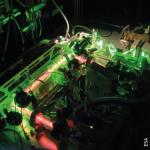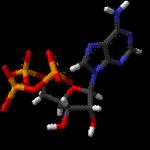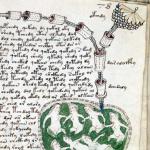During chemical reactions from some substances others are obtained (not to be confused with nuclear reactions, in which one chemical element turns into another).
Any chemical reaction is described by a chemical equation:
Reactants → Reaction products
The arrow indicates the direction of the reaction.
For example:
In this reaction, methane (CH 4) reacts with oxygen (O 2), resulting in the formation of carbon dioxide (CO 2) and water (H 2 O), or more precisely, water vapor. This is exactly the reaction that happens in your kitchen when you light a gas burner. The equation should be read like this: One molecule of methane gas reacts with two molecules of oxygen gas to produce one molecule of carbon dioxide and two molecules of water (water vapor).
The numbers placed before the components of a chemical reaction are called reaction coefficients.
Chemical reactions happen endothermic(with energy absorption) and exothermic(with energy release). Methane combustion is a typical example of an exothermic reaction.
There are several types of chemical reactions. The most common:
- connection reactions;
- decomposition reactions;
- single replacement reactions;
- double displacement reactions;
- oxidation reactions;
- redox reactions.
Compound reactions
In compound reactions, at least two elements form one product:
2Na (t) + Cl 2 (g) → 2NaCl (t)- formation of table salt.
Attention should be paid to an essential nuance of compound reactions: depending on the conditions of the reaction or the proportions of the reagents entering the reaction, its result may be different products. For example, under normal combustion conditions of coal, carbon dioxide is produced:
C (t) + O 2 (g) → CO 2 (g)
If the amount of oxygen is insufficient, then deadly carbon monoxide is formed:
2C (t) + O 2 (g) → 2CO (g)
Decomposition reactions
These reactions are, as it were, essentially opposite to the reactions of the compound. As a result of the decomposition reaction, the substance breaks down into two (3, 4...) simpler elements (compounds):
- 2H 2 O (l) → 2H 2 (g) + O 2 (g)- water decomposition
- 2H 2 O 2 (l) → 2H 2 (g) O + O 2 (g)- decomposition of hydrogen peroxide
Single displacement reactions
As a result of single substitution reactions, a more active element replaces a less active one in a compound:
Zn (s) + CuSO 4 (solution) → ZnSO 4 (solution) + Cu (s)
Zinc in a copper sulfate solution displaces the less active copper, resulting in the formation of a zinc sulfate solution.
The degree of activity of metals in increasing order of activity:
- The most active are alkali and alkaline earth metals
The ionic equation for the above reaction will be:
Zn (t) + Cu 2+ + SO 4 2- → Zn 2+ + SO 4 2- + Cu (t)
The ionic bond CuSO 4, when dissolved in water, breaks down into a copper cation (charge 2+) and a sulfate anion (charge 2-). As a result of the substitution reaction, a zinc cation is formed (which has the same charge as the copper cation: 2-). Please note that the sulfate anion is present on both sides of the equation, i.e., according to all the rules of mathematics, it can be reduced. The result is an ion-molecular equation:
Zn (t) + Cu 2+ → Zn 2+ + Cu (t)
Double displacement reactions
In double substitution reactions, two electrons are already replaced. Such reactions are also called exchange reactions. Such reactions take place in solution with the formation of:
- insoluble solid (precipitation reaction);
- water (neutralization reaction).
Precipitation reactions
When a solution of silver nitrate (salt) is mixed with a solution of sodium chloride, silver chloride is formed:
Molecular equation: KCl (solution) + AgNO 3 (p-p) → AgCl (s) + KNO 3 (p-p)
Ionic equation: K + + Cl - + Ag + + NO 3 - → AgCl (t) + K + + NO 3 -
Molecular ionic equation: Cl - + Ag + → AgCl (s)
If a compound is soluble, it will be present in solution in ionic form. If the compound is insoluble, it will precipitate to form a solid.
Neutralization reactions
These are reactions between acids and bases that result in the formation of water molecules.
For example, the reaction of mixing a solution of sulfuric acid and a solution of sodium hydroxide (lye):
Molecular equation: H 2 SO 4 (p-p) + 2NaOH (p-p) → Na 2 SO 4 (p-p) + 2H 2 O (l)
Ionic equation: 2H + + SO 4 2- + 2Na + + 2OH - → 2Na + + SO 4 2- + 2H 2 O (l)
Molecular ionic equation: 2H + + 2OH - → 2H 2 O (l) or H + + OH - → H 2 O (l)
Oxidation reactions
These are reactions of interaction of substances with gaseous oxygen in the air, in which, as a rule, a large number of energy in the form of heat and light. A typical oxidation reaction is combustion. At the very beginning of this page is the reaction between methane and oxygen:
CH 4 (g) + 2O 2 (g) → CO 2 (g) + 2H 2 O (g)
Methane belongs to hydrocarbons (compounds of carbon and hydrogen). When a hydrocarbon reacts with oxygen, a lot of thermal energy is released.
Redox reactions
These are reactions in which electrons are exchanged between reactant atoms. The reactions discussed above are also redox reactions:
- 2Na + Cl 2 → 2NaCl - compound reaction
- CH 4 + 2O 2 → CO 2 + 2H 2 O - oxidation reaction
- Zn + CuSO 4 → ZnSO 4 + Cu - single substitution reaction
In as much detail as possible, redox reactions with big amount Examples of solving equations using the electronic balance method and the half-reaction method are described in section




1. Indicate the correct definition of a compound reaction: A. The reaction of the formation of several substances from one simple substance; B. A reaction in which from several simple or complex substances, one complex substance is formed. B. A reaction in which substances exchange their constituents.

2. Indicate the correct definition of a substitution reaction: A. The reaction between a base and an acid; B. The reaction of interaction of two simple substances; B. A reaction between substances in which atoms of a simple substance replace atoms of one of the elements in a complex substance.

3. Indicate the correct definition of a decomposition reaction: A. A reaction in which several simple or complex substances are formed from one complex substance; B. A reaction in which substances exchange their constituents; B. Reaction with the formation of oxygen and hydrogen molecules.


5. What type of reactions does the interaction belong to? acid oxides with basic oxides: 5. What type of reaction is the interaction of acidic oxides with basic oxides: A. Exchange reaction; B. Compound reaction; B. Decomposition reaction; D. Substitution reaction.


7. Substances whose formulas are KNO 3 FeCl 2, Na 2 SO 4 are called: 7. Substances whose formulas are KNO 3 FeCl 2, Na 2 SO 4 are called: A) salts; B) reasons; B) acids; D) oxides. A) salts; B) reasons; B) acids; D) oxides. 8. Substances whose formulas are HNO 3, HCl, H 2 SO 4 are called: 8. Substances whose formulas are HNO 3, HCl, H 2 SO 4 are called: A) salts; B) acids; B) reasons; D) oxides. A) salts; B) acids; B) reasons; D) oxides. 9. Substances whose formulas are KOH, Fe(OH) 2, NaOH are called: 9. Substances whose formulas are KOH, Fe(OH) 2, NaOH are called: A) salts; B) acids; B) reasons; D) oxides. 10. Substances whose formulas are NO 2, Fe 2 O 3, Na 2 O are called: A) salts; B) acids; B) reasons; D) oxides. 10. Substances whose formulas are NO 2, Fe 2 O 3, Na 2 O are called: A) salts; B) acids; B) reasons; D) oxides. A) salts; B) acids; B) reasons; D) oxides. 11. Indicate the metals that form alkalis: 11. Indicate the metals that form alkalis: Cu, Fe, Na, K, Zn, Li. Cu, Fe, Na, K, Zn, Li.


“Physics Thermonuclear Reactions” - Thermonuclear reaction. Problem: Plasma is difficult to retain. A controlled thermonuclear reaction is an energetically favorable reaction. Details about the reaction. Physics presentation on the topic: Self-sustaining thermonuclear reactions occur in stars. What is a thermonuclear reaction? TOKAMAK (toroidal magnetic chamber with current).
“Types of chemical reactions” - All reactions are accompanied by thermal effects. Reversible reactions are chemical reactions that occur simultaneously in two opposite directions (forward and reverse) For example: 3H2 + N2? 2NH3 Laboratory work. How can we call the process that is taking place? Chemical reactions occur: when mixing or physical contact of reagents, spontaneously when heated with the participation of catalysts, the action of light, electric current, mechanical action, etc.
“Classification of reactions” - Endothermic reactions: P (red)<=>P (white). S (rhombic)<=>S (plastic). Classification of reactions. The overwhelming majority of such reactions are. Decomposition of potassium permanganate when heated: Lithium combustion reaction: Phosphorus allotropy: Calcium combustion reaction in air: Interesting reactions.
“Nuclear reactions” - Radioactive radiation has a detrimental effect on living cells. Nuclear reactions are accompanied by energy transformations. Biological action. Biological effects of radioactive radiation. The effect of radiation on humans. Thermonuclear reactions. Application nuclear reactions. Nuclear reactor.
“Reactions of acids” - BaCL2 + H2SO4 = BaSO4 + 2HCL Ba2+ + SO42- = BaSO4. Acids. Answers. Classification of acids. Check yourself. Generalization. Typical acid reactions.
1. What reactions are called exchange reactions? How do they differ from combination, decomposition and substitution reactions?
Exchange reactions are reactions in which two complex substances exchange their constituent parts with each other. Thus, complex substances are formed from complex substances. While in decomposition reactions several simple or complex substances are formed from one complex substance, in compound reactions one complex substance is formed from several simple or complex ones, in substitution reactions one complex and one simple substance are formed from one simple and one complex substance.
2. Is it possible to say that the interaction between a solution of a carbonate of a metal and an acid is only an exchange reaction? Why?
3. Write down the equations for exchange reactions between solutions:
a) calcium chloride and sodium phosphate;
b) sulfuric acid and iron (III) hydroxide. 
4. Which of the exchange reactions, the diagrams of which 
will they last until the end? To answer, use the table of solubility of hydroxides and salts in water. 
5. Determine the amount of sodium hydroxide that will be required to completely neutralize 980 g of a 30% solution of phosphoric acid. 
6. Calculate the amount of substance and the mass of the precipitate that formed during the interaction of 980 g of a 20% solution of copper (II) sulfate with the required amount of potassium hydroxide. 




